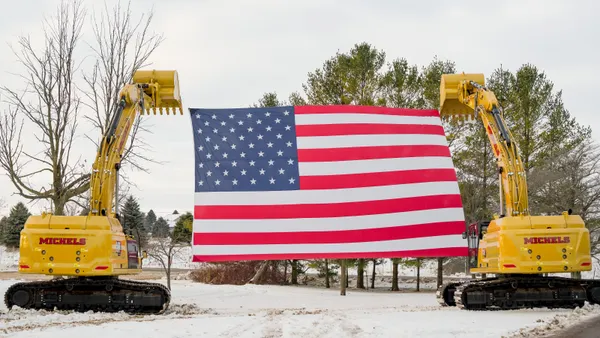The following is a guest post from attorney Stefan Borovina, a member of Goldberg Segalla’s national OSHA and Jobsite Safety practice group. He is also a construction health and safety technician through the Board of Certified Safety Professionals and an OSHA-authorized construction trainer.
For the past year, contractors have faced many challenges keeping jobsites open, productive and safe. While the country has been making a slow recovery, the increase in new variant cases and vaccine delays are signs that the virus may not be going away anytime soon.
For contractors adapting to the “new normal,” another hurdle may be just on the horizon: personal injury lawsuits brought by workers claiming they were exposed to COVID-19 on a jobsite.
While these lawsuits can pose a challenge to contractors, they are not insurmountable. Due to the nature of the virus, proving these lawsuits will not be without difficulties.
What's more, contractors can proactively take steps to mitigate potential liability. The same safety practices that keep contractors in compliance with OSHA can also protect them from personal injury liability in the future.
Proving exposure
While laws can vary from state to state, the basic principles of a personal injury lawsuit are generally similar. Before a contractor can be held responsible for a worker’s injury, the worker will have to prove that the injuring event occurred at that contractor’s jobsite. This is the same whether the lawsuit involves a fall from a scaffold or COVID-19. Unlike a fall from a scaffold however, where it is relatively easy to establish where the injuring event occurred, it can be much more difficult for a worker to prove that he or she was exposed to COVID-19 at a specific jobsite.
The hurdles in proving COVID-19 exposure are twofold: First, how does one prove exposure at a particular location, when, by definition, one can be exposed to the COVID-19 pandemic nearly anywhere? On top of this, the virus has an incubation period of between two and 14 days before symptoms can develop. This means that the onset of symptoms is not necessarily a reliable indicator of when exposure occurred.
Was the exposure work-related?
OSHA considers COVID-19 to be a recordable illness. To comply with OSHA, contractors must record confirmed cases of COVID-19 that are deemed to be “work-related” and also meet at least one of the general recording criteria listed in 29 CFR § 1904.7. Factors that deem a COVID-19 case to be work-related according to OSHA can also be relevant in proving exposure at a jobsite in a personal injury lawsuit.
OSHA has provided guidance on what evidence to consider when determining whether a case of COVID-19 is work-related. A case of COVID-19 illness is likely work-related if it is contracted shortly after lengthy, close exposure to a particular coworker or other person on a jobsite who has a confirmed case of COVID-19. A case may also likely be work-related if the worker’s job duties include having frequent, close exposure to the general public where there is ongoing community transmission.
Notwithstanding the above factors, an alternative explanation for the exposure means that it less likely to be work-related. For example, evidence that a worker lives in the same house as someone who tested positive for COVID-19 can serve as an alternative explanation that a case of COVID-19 was not work-related.
Limit exposure
Keeping compliant with OSHA also means that contractors must take steps to protect employees from known hazards, including exposure to COVID-19. This means that the more a contractor can limit exposure to COVID-19 on the jobsite, the less likely that contractor will be liable for either an OSHA violation or personal injury lawsuit.
COVID-19, like other jobsite hazards, can be mitigated through the effective use of the hierarchy of controls. Contractors should aim to use the most effective control possible given the particulars of the job task or environment. These include practices such as enhanced ventilation and hygiene, social distancing, the use of PPE and staggered shifts.
Contractors should also ensure open lines of communication between workers, supervisors and management. If a worker is symptomatic or tests positive for COVID-19, he or she should be able to quickly and confidentially disclose that information. Contractors should also be able to inform other workers about any exposures on a jobsite while protecting the positive worker’s identity.
Document policies and procedures
While it is important to implement policies and procedures that will limit jobsite exposure to COVID-19, it is equally important to make sure that everything is clearly documented. Once policies and procedures have been written down, that standard should be both consistently trained and enforced on the jobsite. In addition to helping ensure that the policies and procedures will be followed on a jobsite, proper documentation of the policies designed to limit exposure to COVID-19 can help defend against a future lawsuit.
Time will tell how prevalent COVID-19 personal injury lawsuits become in the future. Prudent contractors would be wise to take steps now to avoid future liability. Organized and documented policies and procedures can do more than just help keep contractors OSHA compliant. They can also prevent jobsite exposures to COVID-19 in the first place and — if a lawsuit does occur — help prove that the exposure did not happen on the jobsite.
If you are interested in having your voice heard on Construction Dive's Opinion page, please read our editorial guidelines and fill out the submission form here.





















